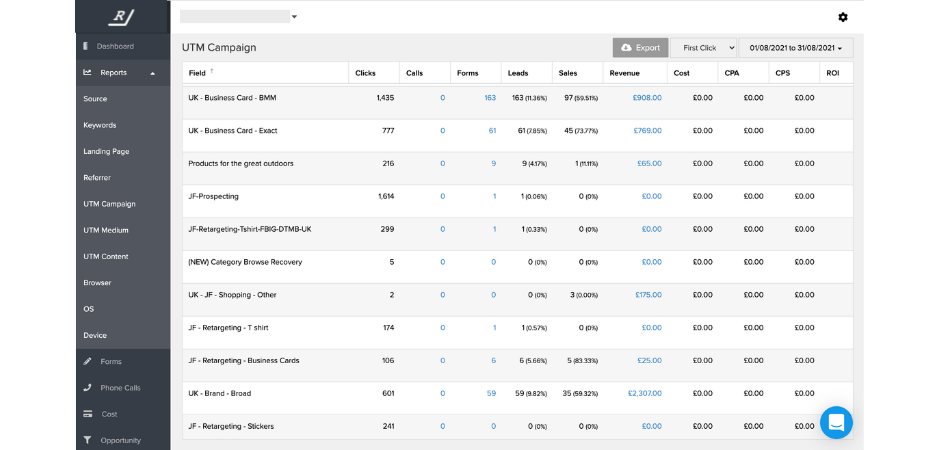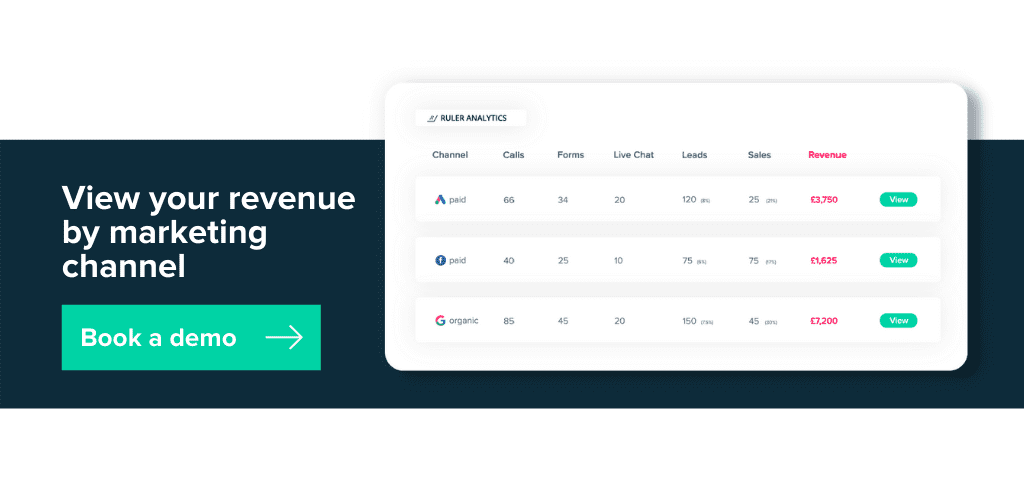Using paid to drive new PPC leads? Pay-per-click is a great way to get your business in front of a targeted audience. And when it’s done right, you can maximise your PPC lead generation and improve the quality.
We found that 54% of marketers use PPC as part of their marketing strategy while 21% struggle to track its impact.
While PPC is a great option for lead generation, it’s easy to rush in too quickly. You can quickly burn through your budget and be left with little more than clicks and impressions.
We’ll split this blog into two parts to help you:
So, let’s get stuck in.
A PPC lead is what it says on the tin. It’s a person who has converted into a lead as a direct result of your pay-per-click campaign.
But remember. Not all users who see and click on your ad will convert right away. Let’s use an example.
Sara visits your website for the first time via a paid ad. But her final conversion into a lead occurred as a result of an organic search online.

But your pay-per-click ad still had an impact as it’s how Sara found you to begin with.
Understanding how PPC and other channels play a role as part of a customer journey is the first step to accurately apply credit.
🚀 Pro Tip
In order to get this kind of view of your data, you need to be using an attribution tool. First, familiarise yourself with attribution by downloading our complete guide to marketing attribution.
Are you having difficulty attributing your inbound leads back to your PPC ads? You’re not alone.
11% of marketers said that paid search generated the most leads. But when we know 54% of marketers are using PPC, that number feels pretty low. So where’s the disconnect?
Well, the simple truth is, it’s hard to connect your leads back to your marketing activity.
Think of it like this. A user on your website is an anonymous visitor. How can you connect that anonymous session to lead information in your CRM? And even more importantly, how can you connect that lead back to a specific marketing touchpoint?
When users are converting via methods like forms, calls and live chat, you’re left with a lot of data points and little ability to bridge the data gap you’re left with.
🚀 Pro Tip
If you’re looking to learn how to better track your inbound leads, then we can help. Read our guides to:
– Track form fills
– Attribute phone calls
– Track live chat
To understand which leads are from which PPC ad, you need to invest in software that will help you track every marketing touchpoint and act as a go-between for your website, your CRM and your analytics tools.
Related: Best PPC reporting tools you need in your marketing stack
Ruler Analytics is a marketing attribution tool that supports you to do just that. With it in place, you can view the performance of your PPC by campaign, ad and even keyword.



👉 Book a demo of Ruler Analytics now to get true oversight of where your leads are coming from.
Think about it.
If you know which campaigns, ads and keywords are driving, not just leads, but revenue, you have all the data in your hands to make data-driven decisions.
Let’s use an example.
You set live two PPC campaigns.
Campaign A drives 5,000 clicks and 20,000 impressions. Campaign B drives 2,500 clicks and 20,000 impressions.
If this is all the data you have access to, you’re going to gun that campaign A worked better, right?
But, with Ruler Analytics in place, you’ll be able to view much more data.
Related: How Ruler impacts your paid advertising strategy
You’ll see that campaign A drove 5,000 clicks, but it only influenced 20 new leads and £5,000 in revenue. Meanwhile, campaign B influenced 50 new leads and £12,000 in revenue.
With this data in play, you can quickly see that campaign B is driving more return on ad spend and therefore has a much bigger impact on your bottom line.
So, you could turn off campaign A, or tweak and try again. And you have this data on a much more granular level too.
You can differentiate your campaigns, your ads and even your keywords. It allows you to turn on and turn off what’s working and what isn’t to help boost your performance and drive more PPC leads.
🚀 Pro Tip
Learn more about how Ruler can help you improve your ROAS, or book a demo to see the data in action
Looking to drive more leads on your website using pay-per-click? Or, getting leads but want to improve the quality?
There’s no point generating hundreds of leads if they don’t result in more revenue.
Lead quality is basically how likely it is that your prospective customers will become paying customers.
Understanding your lead quality as a whole is important. What’s even more important is being able to understand lead quality by channel, campaign and even keyword. The higher quality the leads are, the more likely it is that they will become customers.
Lead quality is not the same as lead volume. In our recent survey, 37% of marketers stated generating high-quality leads was one of their biggest challenges. But why is that?
Nowadays, leads can convert in a multitude of ways. From phone calls, to live chat, form fills and eCommerce. Tracking each of those isn’t an easy task.
And it gets worse. You might be able to track inbound calls as a whole, but are you able to differentiate which inbound calls come from PPC?
Lead volume increasing overall doesn’t necessarily prove that your PPC campaigns are working.
🚀 Pro Tip
Notice a discrepancy between the numbers you see in Google Ads compared to Google Analytics?
You’re not alone. Download our FREE eBook which troubleshoots why this might be happening and how you can ensure you have one single source of truth when it comes to marketing data.
Even if you’re tracking lead volume and you’ve worked out how to distinguish conversions by channel, there’s another issue at play.
While you might be excited to see 2,000 new leads for sales from your PPC campaign, your sales team could be lamenting because they’re not a good fit for your product.
Fundamentally, there’s a huge disconnect between your sales and marketing teams that makes it hard to track your impact across the full funnel.
Related: Guide to sales and marketing alignment
Bridging this gap is the best way to drive more, better quality leads, through your PPC campaigns.
After all, web visitors don’t land on a site and convert right away. And who’s to say that, while your PPC ad isn’t converting new leads right away, that it doesn’t influence any leads at all?
Users could visit your website via a PPC campaign at any point in their customer journey and convert two sessions later. How will you track this?
You’ll never know the true impact of your digital advertising if you look at it in a silo.
Improving your PPC lead quality doesn’t need to be difficult. There’s no one-size-fits-all method to improving PPC lead quality.
If you’re not already tracking your conversions, then you need to.
You can set up some coding or goals in Google Analytics and Google Tag Manager to start tracking form fills, but tracking live chat and phone calls is going to be a bit trickier.
By implementing a marketing attribution tool like Ruler, you can track every conversion type. And, even better, you can see which channels, campaigns and keywords are driving those conversions.
Let’s use an example. John visits your site via a PPC ad and opens a new live chat conversation with your sales team. There, he converts into a lead.


Ruler will track the conversation and conversion and highlight that the PPC campaign drove the live chat conversation. In your CRM, you’d see this live chat conversion accurately attributed on a last-click basis to PPC.
👉 Book a demo of Ruler Analytics to see how we integrate with your CRM.
While John converted directly from your PPC campaign, this isn’t always the case.
For example, Sara first visited your site via a paid session. She returned via a paid Facebook ad session.
She visits again via an organic session where she converts. While the organic session drove the conversion, the paid ad had a clear impact.



With Ruler, you can see the true impact of your paid advertising thanks to a full customer journey view. And remember, Ruler doesn’t just store this data, it will also forward it to your chosen apps. That means, in your Ads Manager, you’d be able to see Sara’s lead conversion accurately attributed to PPC, all the way down to which keyword she used.
👉 Book a demo to see how we fire data to your chosen marketing apps.
If you’re directing significant parts of your budget to paid media spend, you want to ensure you’re getting a good return on investment.
For eCommerce businesses, it’s a lot easier as there’s a more obvious balance between profit margins.
However, for B2B businesses, particularly those with a long sales cycle, it can be tricky.
A company specialising in financial services, for example, might earn thousands from one client. This means they have much more budget to play with to attempt to get clients.
You can use a closed-loop attribution tool like Ruler which gives you definitive proof of the value of your leads.
You can use this real-time data to understand how much each marketing channel is bringing in. But you can go even further. You can use this form of attribution to look at how much revenue each ad you create brings in.


It can be tempting to remove keywords that have a low CTR or conversion rate from our Ad settings. Say for example, you have a keyword of ‘hot chocolate’, that converts 15 people into form submissions or phone calls.
You have another keyword meanwhile, that converts 50 people.
From those stats, it seems like the one that converted 50 is better, right? Not necessarily. These stats only indicate the potential of a keyword. What we really need to look at, is how many sales did that keyword generate.
You can do exactly that by using a marketing attribution tool like Ruler Analytics.
This allows you to pinpoint the performance of individual keywords and their effectiveness at converting prospects to customers. Once you understand which keywords are performing better, you can then turn off any that aren’t resulting in sales.



Just like anything it takes time to improve your PPC lead quality. But remember, you should be testing your marketing. That includes tweaking your targeting, conducting A/B tests and trying new ad formats.
Apply a formulaic approach to your PPC leads and you’ll slowly but surely see marginal gains in lead quality.
Understanding your paid advertising doesn’t need to be tricky.
Whether you’re using eCommerce and want visibility of the full customer journey or need help tracking conversions like live chat, form fills and phone calls, Ruler is the perfect tool for any paid media marketer.
Learn more about what Ruler can do for you by booking a demo with our team. We’ll show you the data in action and what insights you can get thanks to Ruler’s closed-loop method.

